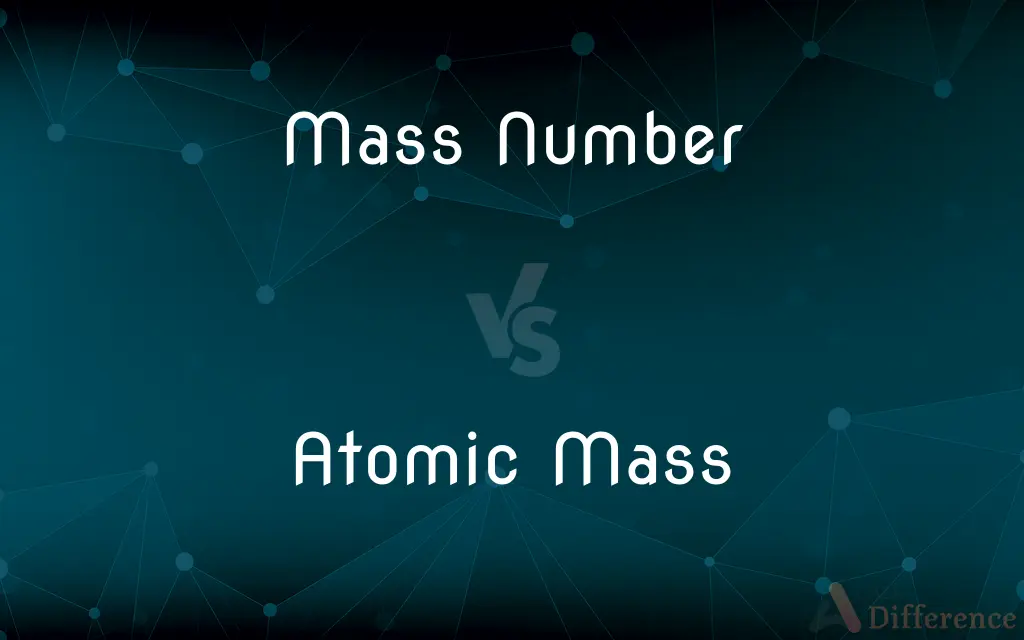Mass Number vs. Atomic Mass — What's the Difference?
By Tayyaba Rehman — Published on December 10, 2023
Mass Number is the sum of protons and neutrons in an atom, while Atomic Mass is the weighted average of all isotopes of an element, measured in atomic mass units (amu).

Difference Between Mass Number and Atomic Mass
Table of Contents
ADVERTISEMENT
Key Differences
Mass Number and Atomic Mass are fundamental concepts in the study of atoms. Mass Number pertains to a specific atom, representing the combined total of its protons and neutrons.
Conversely, Atomic Mass provides a broader perspective, being the weighted average of the masses of all the isotopes of a particular element. This means it takes into account the proportion of each isotope in nature when providing an average mass.
While Mass Number is always a whole number (since you can't have a fraction of a proton or neutron), Atomic Mass can be a fraction. This is because of the averaging process of various isotopes, some of which might have different numbers of neutrons and thus different masses.
When considering a specific isotope of an element, the Mass Number becomes particularly significant. In contrast, if one wants a generalized understanding of an element's mass as it typically appears in nature, Atomic Mass offers a more holistic view.
To summarize, while both Mass Number and Atomic Mass pertain to atomic weight, they approach the topic from different angles: one from the perspective of a specific atom and the other from the collective perspective of all an element's isotopes.
ADVERTISEMENT
Comparison Chart
Definition
Total protons and neutrons in an atom
Weighted average of the masses of an element's isotopes
Represents
A specific atom or isotope
An entire element
Numeric Value
Whole number
Can be a fraction
Depends On
Number of protons and neutrons
Proportions and masses of all isotopes of an element
Used In
Isotope notation
Periodic table values
Compare with Definitions
Mass Number
Mass Number is the sum of protons and neutrons in an atom.
The Mass Number of carbon-12 is 12.
Atomic Mass
Atomic Mass provides a comprehensive understanding of an element's mass.
To determine the average weight of natural silver, refer to its Atomic Mass.
Mass Number
Mass Number helps identify isotopes.
Carbon-14 has a Mass Number of 14 due to additional neutrons.
Atomic Mass
Atomic Mass is the weighted average mass of an element's isotopes.
The Atomic Mass of chlorine is about 35.5 amu.
Mass Number
Mass Number determines the atomic nucleus's mass.
An element's nucleus weight is primarily dictated by its Mass Number.
Atomic Mass
Atomic Mass is usually measured in atomic mass units (amu).
Oxygen has an Atomic Mass of roughly 16 amu.
Mass Number
Mass Number differs among isotopes of the same element.
Different isotopes of carbon have varying Mass Numbers.
Atomic Mass
Atomic Mass can be a fractional value.
Hydrogen's Atomic Mass is approximately 1.008 amu.
Mass Number
Mass Number is always a whole number.
No atom can have a Mass Number of 12.5.
Atomic Mass
Atomic Mass reflects the natural abundance of isotopes.
Carbon's Atomic Mass is close to 12 amu because carbon-12 is the most abundant isotope.
Common Curiosities
How does Atomic Mass differ from Mass Number?
Atomic Mass is the weighted average mass of all isotopes of an element, while Mass Number pertains to a specific atom.
What does Mass Number represent?
Mass Number represents the total number of protons and neutrons in an atom.
Is Mass Number ever a fraction?
No, Mass Number is always a whole number.
Why is Atomic Mass sometimes not a whole number?
Atomic Mass can be a fraction due to the weighted averaging of various isotopes.
Does Mass Number vary for different isotopes of the same element?
Yes, different isotopes have different Mass Numbers.
How is Atomic Mass measured?
Atomic Mass is measured in atomic mass units (amu).
What does the Atomic Mass of an element on the periodic table represent?
It represents the weighted average mass of all its isotopes.
How do isotopes affect Atomic Mass?
Isotopes, due to their varying numbers of neutrons, have different masses which influence the weighted average Atomic Mass.
Why are protons and neutrons central to the concept of Mass Number?
Because Mass Number is the sum of an atom's protons and neutrons.
Is the Mass Number the same for all atoms of an element?
No, it varies among isotopes of the same element.
Can two different elements have the same Mass Number?
Yes, but they will still differ in the number of protons and atomic structure.
Does Mass Number include electrons?
No, Mass Number only includes protons and neutrons.
Why is Atomic Mass important in chemistry?
It's vital for calculations involving moles, stoichiometry, and other chemical reactions.
How is Atomic Mass determined?
It's determined by averaging the masses of all isotopes of an element based on their natural abundance.
Which is more specific, Mass Number or Atomic Mass?
Mass Number is more specific as it relates to a specific atom, whereas Atomic Mass provides a general view for an element.
Share Your Discovery

Previous Comparison
MUV vs. SUV
Next Comparison
MPG vs. MP4Author Spotlight
Written by
Tayyaba RehmanTayyaba Rehman is a distinguished writer, currently serving as a primary contributor to askdifference.com. As a researcher in semantics and etymology, Tayyaba's passion for the complexity of languages and their distinctions has found a perfect home on the platform. Tayyaba delves into the intricacies of language, distinguishing between commonly confused words and phrases, thereby providing clarity for readers worldwide.












































